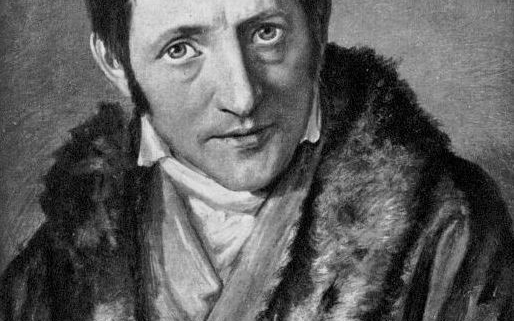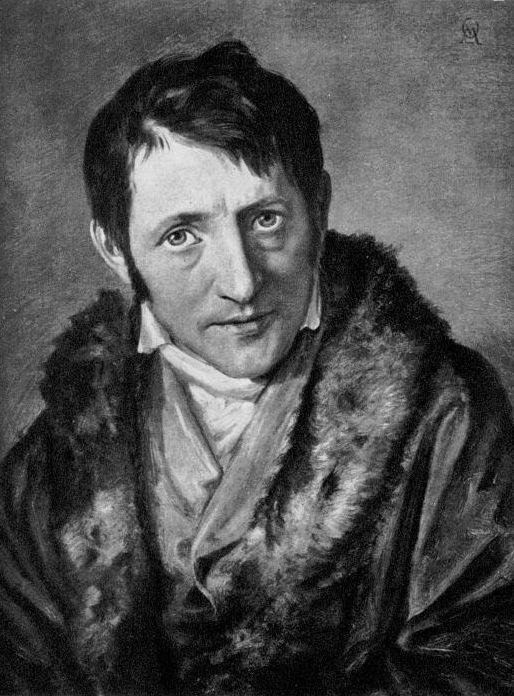The Sentencia-Estatuto of 1449
The Sentencia-Estatuto of 1449: Translated from Spanish to English and with an Introduction by Wilhem Ivorsson
Translator’s Notes:
The reader should keep in mind that this text is 575 years old. Many of the political titles and legal concepts referenced do not have modern equivalents, and the document was written in period-specific legal language, style and custom. The text is not very accessible even for a modern Spanish-speaking audience let alone an English-speaking one. Such being the case, I took a few liberties to increase the readability. This involved slightly rewording certain conjunctive phrasings and adding periods to delineate some tracts that otherwise would not sensibly translate to English; adding qualifying particles between brackets; and periodically omitting a redundant word. I also maintained English grammar rules regarding cases; I always capitalize “Catholic” and “Lord King” whereas the original does not. Aside from these changes, I have strived to retain the original semantic value, tone and structure. For the source text, I primarily used the reproduced copy found in Eloy Benito Ruano’s Toledo En El Siglo XV published by the University of Madrid in 1961. I also consulted the reproduced copy in Antonio Martín Gamero’s Historia de la Ciudad de Toledo published in 1862. Below is a longform translation, but I have also provided a simplified translation that omits less important elements and takes more liberties to achieve greater accessibility. You can read it here. You can also view the original Spanish text here.
Preface
The Sentencia-Estatuto has been highlighted as one of the foundational documents of Spain’s Limpieza de Sangre policies. It was written in June of 1449 during Toledo’s rebellion against the crown. In January the Castilian constable Alvaro de Luna demanded the city provide a loan of one million maravedis to Juan II’s court. The loan was advertised as a means to confront the kingdom’s mounting military threats from Aragon to the Northeast and the Moors to the South. To procure the money for the loan, the city treasurer, Alonso Cota, a converso of Jewish heritage,1 imposed a tax on the commoners at the rate of dos doblas. Many believed that Alvaro de Luna and Alonso Cota “had devised the loan for their own personal gain; Cota was to reap his profit as tax farmer, and Alvaro was to get his bribe from Cota.”2 When Alonso’s men forcefully took the dos doblas from a lowly leather worker,3 the city erupted in protest. Enraged citizens ransacked Alonso Cota’s multiple homes. Afterwards they attacked and pillaged the Magdalena quarter4 where all the wealthy conversos and Jews were known to reside.
A nobleman, Pedro Sarmiento, took charge of the agitated masses and assumed effective control over Toledo. A few conversos took up arms against the rebels and were killed. Others were banished from the city and their homes and property confiscated. Over the next several months Juan II’s and De Luna’s forces undertook a siege campaign against the city. As the Sentencia-Estatuto stated, the royal court waged “a cruel war of blood and fire, of crop destruction and pillaging” against the citizens of Toledo. Periodically, Sarmiento engaged in negotiations with the king for the safe return of the city. One of the stipulations was that Alvaro de Luna be removed from Juan II’s court. As Spanish historian Eloy Benito Ruano explains, it was believed that De Luna had sold a number of public offices to the conversos and that he had “taken over the will of the King” and protected many “heretics and Judaizers.”5 Regarding converso overrepresentation in Juan II’s court, the late Jewish scholar Benzion Netanyahu (Benjamin Netanyahu’s father) said that:
…there can be no doubt that the influence of the conversos in the royal secretaryship was one of the factors determining the appointments of the cities’ chief authorities…the crowning achievement of the conversos in government was attained through their membership in Castile’s royal Council…Toward the end of [Juan II’s reign] they probably comprised no less than a third of its members, reaching at that time the zenith of their influence in determining the actions and policies of the state.6
The Sentencia-Estatuto explicitly stated, referring to the public notaries, that it was “well known to all, that the majority of said notary positions, said conversos tyrannically held and possessed, as much by the purchase with money as by favors and other clever and deceptive means.” The document emphasized that conversos should “especially” be barred from these offices and their “exemptions” which probably involved immunities from certain taxes and related financial obligations.
The Sentencia-Estatuto also rendered conversos ineligible to act as witnesses in court against old Christians. Many modern commentators view this as a historical novelty, but long before the Sentencia-Estatuto, Christians were not allowed to testify against Jews in Rabbinic courts,7 and Talmudic Mesirah laws often forbade Jews from denouncing fellow Jews to non-Jewish authorities. In addition, the Talmud sometimes forbids Jews from testifying against other Jews in secular courts.8 Even today, there is evidence that Jews still culturally adhere to these laws. For example in 2006, Israeli-American real estate investor Solomon Dwek was convicted of felony fraud after trying to steal $50 million from PNC Bank in a check-kiting scheme. Subsequently, he became an FBI informant and his father, Rabbi Dwek, famously denounced him from the pulpit at his synagogue, citing the Talmudic law of moser.9 His father even reportedly said that he would be sitting shiva, a week-long morning ritual, because he considered his son dead.10
While the Sentencia-Estatuto is not explicit on the matter, its statements easily lend themselves to a supposition that conversos would testify in secular courts against old Christians on behalf of fellow conversos in an ethnocentric fashion. With this in mind, the Sentencia-Estatuto outright accused the conversos of systematically taking over Toledo’s government, running it into the ground, and purposefully dispossessing many old Christian nobles:
…through cunning and deceit, [the conversos have] taken and carried off and stolen large and innumerable amounts of maravedis and silver from our king the lord and from his rents, rights, and taxes, and they have destroyed and ruined many noblewomen, knights and hidalgos. Consequently they have oppressed, destroyed, robbed and ravaged all the most ancient houses and estates of the old Christians of this city and its land and jurisdiction and all the realms of Castile, as is well known and as such we regard it. Furthermore, during the time that they have held public office in this city, and its management and administration, the greater part of said city’s centers have been depopulated and destroyed; said city’s own land and centers [have been] lost and alienated. Beyond all this, all the maravedis of said city’s income and property have been consumed in their own interests and properties, in such a manner that all of the country’s wealth and reputation have been consumed and destroyed.
All this said, the Sentencia-Estatuto is sometimes viewed as a post-hoc justification for the Toledans to rob and pillage the city’s wealthy conversos. Benzion Netanyahu claimed that Sarmiento lacked the support of the upper class nobles, and so he seized on the commoners’ animosity toward conversos in order to undermine Alvaro de Luna. He argues that Sarmiento was “a second-rate nobleman, with mediocre estates and moderate income”11 who felt entitled to greater monetary compensation for his past services to the king. In Netanyahu’s view, the rebellion was not an organic event, and Sarmiento premeditated and orchestrated the entire affair because of “hurt feelings” and a fear of “an impending disaster,”12 after he became convinced that De Luna had begun to see him as a political enemy.
I don’t think Netanyahu’s accounting of Sarmiento’s motives holds up under scrutiny. The converso overrepresentation in Juan II’s court and Alvaro de Luna’s support base by his own admission was a very real thing. The nobles were likely just as aware of it as the commoners, if not more so. In the years leading up to the rebellion, Alvaro de Luna and Juan II had been alienating their rivals, perceived or otherwise, by imprisoning them and seizing their assets. It was not the case that aside from Sarmiento and the commoners, all was well and good in Castile.13 It seems rather unlikely that Castilian nobility hadn’t begun to notice any patterns in terms of who was and wasn’t among De Luna’s and Juan II’s support base. Moreover, similar displays of ethnic strife between conversos and old Christians occurred in Ciudad Real a mere 15 days following the outbreak of the Toledan rebellion. “The [converso] tax collector Juan González (later burned by the Inquisition) and three hundred other men of said ancestry armed themselves and took to the streets, threatening to burn down the city before anyone decided to attack them.” This too was all apparently in a “dispute over the possession of the public notaries which it was said were bought by Judaizers and New Christians.”14 Even if Sarmiento orchestrated the rebellion in Toledo, as Netanyahu argues, he didn’t invent the larger ethnic conflict that was brewing in the region, nor did he invent converso overrepresentation in the notaries, which seems to have been ubiquitous throughout the region.
Many modern academics and commentators might argue here that such overrepresentation in the notaries could be attributed to an intelligence advantage rather than an ethnocentric in-group strategy. The evidence at hand, however, doesn’t support such a conclusion. Richard Lynn’s notable book, The Chosen People: A Study of Jewish Intelligence and Achievement, states that the bulk of Sephardic Jews expelled from Spain in 1492 moved to the Balkans, (p. 335) where the Sephardic IQ is currently 98. (p.298) In Lynn’s The Intelligence of Nations, the Spanish national IQ was rated at roughly 94. (p. 145) While statistically significant, a four point difference isn’t very compelling to support the former hypothesis. Moreover, another paper by Lynn, North-South Differences in Spain in IQ,15 reports that the average IQ in Northern Spain is 101 while the average in the South is 96. The average IQ for Catalonia and Valencia in Lynn’s paper was 102.
There is another paper, Numeracy of Religious Minorities in Spain and Portugal in the Inquisition Era, (Juif et al 2019)16 that attempts to compare the numeracy rates of “Jewish-accused” conversos with those of the broader Catholic masses during the Inquisition. The goal was to find evidence of “Jew’s human capital relative to the non-Jewish majority’s.” The study never discusses IQ directly, but it seeks to correlate rates of numeracy with education level which in turn can be correlated with IQ. The study’s finding was that Jewish-accused individuals had higher numeracy rates compared to the broader population, but the study also states that “Catholic priests and other groups of the religious elite who were occasional targets of the Inquisition had a similarly high level of numeracy.” This would suggest that, regardless of ethnicity, there was a high rate of numeracy within the higher socioeconomic rungs of Spanish society. The Inquisition does not appear to have targeted individuals of lower socioeconomic status.
If we consider that, by virtually all accounts, the sephardic Jews were not peasants, but rather a monied class of relative high socio-economic status,17 it may well be that the average converso indeed had a higher IQ than the average old Christian peasant. Even so, there is no evidence that the conversos were significantly more intelligent than the old Christian nobility such that one would expect the conversos to dominate the notaries. People have produced various estimations for the population of each major ethnic bloc in medieval Spain. None of them are particularly convincing, but with that caveat in mind, the total population in 1492 is generally said to have been around three million. The Jews, it is said, were around 300,000. Supposedly, there were half a million Muslims. If those figures are accurate, it would be informative to ascertain how many of the 2.2 million old Christians were of the noble classes. It may be that the old Christian noble classes numerically comprised a similarly small figure relative to the larger population of commoners. In effect, there may have been two relatively small but high socioeconomic rungs of Spanish society roughly of equal intelligence and size in the ‘resource competition theory’ that Kevin MacDonald has forwarded in his book, A People That Shall Dwell Alone. In such a setting, the conversos would be at an advantage only if they had adopted a group strategy against the old Christian nobles who in contrast had remained relatively individualistic until the implementation of Limpieza de Sangre policies.
It also appears to be the case that in none of the contemporary documents that sought to condemn Sarmiento’s rebellion does anyone counter the basic idea that conversos were indeed overrepresented in the manner Sarmiento and others described. Critics simply accused the rebels of having acted without proper cause and justification.
As far as Sarmiento’s motives go, they appear to have gone well beyond personal interests and ambitions. It is far more likely that he was sincerely motivated by a moral and religious conviction—perhaps even an emergent ethnic awareness—to protect his fellow old Christians from what he saw as their abuse and exploitation on the part of a hostile outgroup. If Sarmiento was only interested in political expediency, it was not a wise move for him to take up a stance that burned all possible bridges with the converso power base in such an exceedingly dangerous setting. Once the Toledan rebellion began, Juan II officially revoked and seized Sarmiento’s titles and properties, and sought to bring him and all his supporters to justice. Even Pope Nicholas V condemned the rebellion. He excommunicated Sarmiento along with over 500 others for their actions, and declared the entire city in “entredicho” which essentially barred all its inhabitants from participating in various ecclesiastical affairs.18 He then published the document Humani generis inimicus, (Enemies of the human race) in which, as Benito-Ruano put it, “he affirmed the unity of the Christian flock, regardless of the ancestry of its members in the faith, as well as their equal rights to obtain ecclesiastical and civil jobs or benefices.”19
As remarkable as this opposition to anti-converso sentiments was, plenty of other local nobles supported Sarmiento and the rebels’ cause. Curiously, prince Enrique had not been on good terms with his father, and there is reason to think that he clandestinely supported the rebellion’s anti-converso aims. During the rebellion, the prince was welcomed into the city by the rebels, and he had agreed to all of their demands. None of the rebels would be tried for their crimes, none of the property stolen would be returned to the conversos, and none of the conversos banished from the city would be allowed to return. It does appear that after a series of political intrigues, Enrique may have had a falling out with Sarmiento, but the details that the Crónica de Juan II provides seem strange.
The chronicle tells us20 that in November of 1450, with the rebellion still ongoing, the prince learned and disapproved of certain excesses Sarmiento had been engaged in.21 He left his stronghold in Segovia and made his way to Toledo to remove Sarmiento, whom we are also told was plotting to hand over the city to the king.22 This doesn’t make much sense. The prince had been amenable to Sarmiento’s aims while the king had not. The chronicle also states that the prince didn’t take any action against Sarmiento when he first entered the city. In fact, it expressly states that the prince participated in a series of games for “eight to ten days” before finally getting around to summoning Sarmiento. He then asks Sarmiento to hand over his positions to Don Pedro Giron, the Maestre de Calatrava.23
Supposedly, a few days after this, the bishop of Cuenca spoke to Sarmiento on behalf of the prince. He told Sarmiento that the prince wanted him to leave the city.24 The bishop then gave a scathing critique and condemnation of Sarmiento’s behavior. The chronicle condemned Sarmiento for having rebelled against his king, but Enrique, the king’s own son, was no less guilty of this. The same chronicle discusses how the prince impeded several plots on the part of disillusioned rebels to hand the city back over to his father. Moreover, Enrique did not arrest Sarmiento. Instead he granted Sarmiento safe passage to his power center in Segovia. He even allowed Sarmiento to leave the city with all his possessions and wealth, including what the same chronicle accuses Sarmiento of having plundered from the conversos.
The chronicle has several characters pleading with the prince to stop Sarmiento from leaving Toledo with “mas de treinta cuentos.” This presumably means “more than 30 million maravedis.” While maravedis don’t indicate actual coins here, the amount of money here seems absurd and fantastical. Beyond it being 30 times the original loan that instigated the rebellion, the amount would likely have been so physically large and heavy that Sarmiento could not possibly have carried it out of the city. Even Benzion Netanyahu stated that “this does not seem possible.”25 Assuming Sarmiento had 15 million doblas weighing around four grams each, the treasure would probably have weighed over 130,000 lbs. Technically though, the chronicle tells us that Sarmiento left “without the gold and the silver he had stolen” and instead much of what he carried out of Toledo were tapestries, rugs, fancy underwear, bed spreads, silk fabrics, and fine gems. It doesn’t seem any more likely that Sarmiento carried off the equivalent value of 30 million maravedis in these items.
The text does assert that Sarmiento’s caravan had “close to two hundred” beasts of burden, but even if this is true, that wouldn’t have sufficed. Assuming that each animal weighed around 1000 lbs and could carry 20% of its own weight, the maximum carrying capacity of Sarmiento’s caravan would’ve been about 40,000 lbs. And there is still the consideration that once outside the city, such an amount of wealth would’ve required a small army to defend, which Sarmiento, a minor noble, clearly did not possess. Indeed, after Sarmiento’s caravan leaves Toledo, the chronicle has his servants steal his belongings and abandon him over the course of several days. He is robbed by bandits on the road and the very cities he approaches seeking refuge. Even the king at one point confiscates part of what Sarmiento supposedly stole, when the latter is forced to abandon it at a former residence, and yet curiously the king doesn’t give the property back to its rightful owners.26 The account appears purposefully tailored to vilify Sarmiento in a caricatured fashion. Benzion Netanyahu notes that the dialogue between Sarmiento and the bishop of Cuenca is not present in the Crónica del Halconero; it’s only found in the Crónica de Juan II. He calls the account in the latter chronicle, a “tendentious story, which might have been produced by some admirer of Barrientos (in all likelihood, a converso author)…”27
It’s entirely possible that Sarmiento had aggravated the prince by imprisoning certain noblemen whom the prince felt were honorable, but elements of the chronicle are clearly histrionic in nature. It seems more likely that the prince asked Sarmiento to leave the city after Pope Nicholas’s bull against the rebels had been locally issued. The prince may have been concerned with optics and felt that Sarmiento’s departure would ease tensions.28 Either way, the rebellion continued without Sarmiento’s direct participation for over another year, and when it was over, it had effectively accomplished all that he and his followers had set out to achieve.
On March 21st of 1451, Juan II saw fit to pardon all the Toledan rebels. No one was to be punished for their actions, and even more amazing, none of the property taken from the conversos was to be returned.29 It can be deduced from a letter dated to August 13th, 1451 that Juan II also upheld the rebellion’s measure to remove conversos from public office in Toledo.30 On November 20th of the same year at Juan II’s request, the Pope removed the excommunication status from the city.31 Even Sarmiento was eventually pardoned in 1452, and all his former titles and estates were restored. Although Juan II never allowed him to return to court, Sarmiento became a member of Enrique’s court once he succeeded his father to the throne. Sarmiento died naturally in 1463, probably due to parkinson’s disease, having successfully passed on his mayorazgo to his son.32 Alvaro de Luna on the other hand, following another set of attempts at power grabs, was arrested in 1453 by Enrique who had the former constable convicted for usurping royal functions and subsequently beheaded.33
By 1478 the Inquisition was established in Castille via a papal bull with the goal of combating the Judaizing practices of the conversos. By 1483, it was established in Aragon. The former reluctance on the part of the papacy to engage in prejudicial actions against persons of Jewish ancestry had evaporated. In 1492 at the culmination of the Reconquista, Spain enacted the Edict of Expulsion (Decreto de la Alhambra or Edicto de Granada) which expelled all practicing Jews who refused to convert to Catholicism. Those who rejected conversion were given six months to sell their assets, conclude their affairs, and move abroad.34 Although thousands of Jews left, it’s generally believed that the bulk of them opted to convert, and following the historical pattern since the times of the Visigoths, these conversions were in all likelihood mostly insincere. Many of the new converts continued to practice Judaism in secret and maintain old ethnic ties and allegiances and intermarry among themselves. It was in this setting that Limpieza de Sangre became official state policy in Spain.
Benzion Netanyahu asserted that the Spaniards had adopted “the principle of race to discriminate against all conversos” and asked why the Spaniards being so “constitutionally dedicated to the defense of Christian cult and doctrine [would] adopt a policy so alien…so opposed to its laws, teachings and traditions?”35 Perhaps we can find an ironic answer to this question in chapter four of Kevin MacDonald’s Separation and Its Discontents:
The Inquisition was fundamentally a response to failed attempts to force genetic and group assimilation. The real crime in the eyes of the Iberians was that the Jews who had converted after 1391 were racialists in disguise, and this was the case even if they sincerely believed in Christianity while nevertheless continuing to marry endogamously and to engage in political and economic cooperation within the group. Those who had voluntarily assimilated prior to 1391 were not targets of the Inquisition, since such individuals were implicitly viewed as being free from the crime of racialism. It was not the extent of Jewish ancestry that was a crime, but the intentional involvement in a group evolutionary strategy. In this sense, the Inquisition was profoundly non-racist. Rather, it was concerned with punishing racialism.36
Some of MacDonald’s assertions may appear odd, since the Inquisition later developed an entire racial caste system in the Americas. But the historical evidence strongly indicates that the emergent Spanish attitudes toward conversos were formed in response to ethnocentric converso collectivism against old Christians. It should be considered here that the tendency of Christianity in Spain had been to dissolve older ethnic distinctions. The Visigoths had forbidden intermarriage between themselves and local Hispano Romans until the mid 7th century when Recceswinth dissolved the old law in order to promote cultural unity.37 To be clear, these observations are not intended to imply that the Jews of Spain bore responsibility for the Spaniards’ subsequent implementation of their racial caste system in the Americas. As MacDonald also states in his work, “evolutionary theory must also suppose that these tendencies are in no way exclusive to Judaism…”38 My intent here is to discourage academics and others from viewing the emergence of Limpieza de Sangre policies as the progenitor of modern racism.
Beginning of the Translated Text:
In the very noble and very loyal city of Toledo, five days into the month of June, in the year of the birth of our Savior Jesus Christ, one thousand four hundred and forty nine; on this day, standing present in the house and hall of said city of Toledo, the very honorable and noble gentleman Pedro Sarmiento, repostero mayor39 of our Lord the King and his council, and alcalde de las alzadas40 in said city of Toledo and its realm, boundary, and jurisdiction by way of said Lord King, and [standing present] the judges, sheriffs, knights and squires, commoners and people of said city of Toledo, assembled according to habit and custom, especially to hear, discuss, negotiate and provide in the administration and good governance of said city and in other things pertaining and convenient to the service of our Lord God, of said Lord the King and of the public welfare of said city and its residents and inhabitants, and in the presence of myself, Pasqual Gómez, public scribe in Toledo and scribe of the councils of said city, and [in the presence] of the witnesses listed below, Esteban García de Toledo personally appeared in said council in name, and as the representative that he is, of said judges, sheriffs, knights, squires, commoners and people of said city, whose power of attorney passed before me, the aforementioned scribe. [Esteban García de Toledo] spoke with the gentlemen named above, who well know how on many days and in different councils they had discussed and understood about the universal wellbeing of said city, and of the privileges, exemptions and freedoms given and granted to it by the kings of very glorious memory, progenitors of our Lord the King, and by their highness [said privileges, exemptions and freedoms were] confirmed and sworn.41 Among these [privileges, exemptions and freedoms, Esteban García de Toledo] says there was a privilege given and granted to said city by the Catholic of glorious memory, Don Alfonso, king of Castile and Leon, whereby, among other graces, freedoms, and immunities given and granted by him to said city, following the spirit and letter of the law and the holy decrees, [Don Alfonso] ordered and decreed that no converso with Jewish lineage could hold or keep any office or benefice in said city of Toledo, nor in its land, boundary and jurisdiction, for being suspect in the faith of our Lord and Redeemer Jesus Christ, and for other causes and reasons contained within said privilege.
The aforementioned lords had deliberated a few times on the public notaries of said city, which were and are offices that consist in the service of said Lord King and a great part of the benefit of all public things of said city. They had seen and heard, and it was well known to all, that the majority of said notary positions, said conversos tyrannically held and possessed, as much by the purchase with money as by favors and other clever and deceptive means. This was done in contempt of the royal crown of our Lord the King, of said privileges, exonerations, freedoms and immunities of said city, and of the old Christians proper.42 About all this and other things pertaining to the service of God, of said Lord King, and of the public welfare of said city, [the aforementioned lords] had agreed to make a pronouncement and declaration beyond their mercy to date. Consequently, in name of said city, its commoners and people, and in the best manner [Esteban García de Toledo] was able, and was compelled by law to do so, he requested and did request, he demanded and did demand, that [the aforementioned lords] declare and pronounce on all that they understand to be in service of God our Lord and of said Lord King and of the common interest and advantage of said city.
And promptly the aforementioned Pedro Sarmiento and the aforementioned judges, sheriffs, knights and squires, commoners and people of said city, stated that they had already seen and deliberated about what the aforementioned Esteban García stated, and [that] they had ordered him to see his lawyers, intending to be compliant in the service of God, of said Lord King, and of the public welfare of said city. Consequently, above and beyond everything else declared and pronounced by them in the trial that said city brings against its enemy residents for the offenses and crimes committed and perpetrated by them against the service of God, and of said Lord King, and of the public good of said city, the aforementioned lords agreed to make a certain declaration, and they promptly gave another judgment, and they made me, the aforementioned scribe, read it, the tenor of which, with what happened later, is what follows:
«We, the aforementioned Pedro Sarmiento, repostero mayor of our Lord the King and of his council, and his asistente43 and alcalde mayor de las alzadas of the very noble and very loyal city of Toledo, and the judges, sheriffs, knights, squires, citizens and people of said city of Toledo, named above, pronounce and declare that, inasmuch as it is well known by law both canonical and civil, that conversos of Jewish lineage, for being suspect in the faith of our Lord and Savior Jesus Christ, the faith which they frequently profane by judaizing, may not hold such offices or benefices public or private through which they might inflict shame, damages or abuses on old Christians proper, nor may they qualify as witnesses against them. For this reason, privilege was given to said city and its residents by Don Alfonso of glorious memory, that these conversos not hold nor be able to hold said offices or benefices under pain of severe and grave punishments, and because against a very large part of this city’s conversos, descendants from the lineage of its Jews, it is proven, and it seemed and evidently seems, that they are persons highly suspect in the holy Catholic faith, holding and believing profound errors against the articles of the holy Catholic faith, guarding the rites and rituals of the old law, and saying and affirming that our Savior and Redeemer Jesus Christ is a man belonging to their lineage whom the Christians adore as God. And furthermore, [because] they affirm and say that there is a God and a Goddess44 in heaven. And furthermore, [because] on Holy Thursday, while the holiest oil and chrism are consecrated in the Holy Church of Toledo, and the Body of our Redeemer is placed on the Altar, said conversos slaughter lambs and eat them and make other kinds of burnt offerings and sacrifices judaizing. [This is] according to what is contained at length in the inquiry conducted for this reason by the vicars of said Holy Church of Toledo. By virtue [of its findings], the royal justice, following the letter of the law, proceeded heartedly against some of them, and from there, as the holy decrees have deduced, it turns out that most of said conversos do not think well of the holy Catholic faith. Said inquiry we have included here and ordered it to be placed in the archives of Toledo. Additionally, because beyond what has been said above is well known in this city, and as such we have declared it as fact and well known that said conversos live and act without fear of God. And furthermore they have shown and show themselves to be enemies of said city and its old Christian residents, and that notoriously at their petition, insistence and solicitation, a royal tax was placed on said city by the constable Don Alvaro de Luna45 and his henchmen and allies, our enemies, waging a cruel war of blood and fire, of crop destruction and pillaging, as if we were Moors, enemies of the Christian faith.
Such damages, evils, and wars, the Jews, enemies of our holy Catholic faith, have always caused, manifested, and even implemented since the passion of our Savior Jesus Christ. Even the Jews who lived in this city long ago, according to our ancient chronicles, when it was surrounded by the Moors, our enemies, led by their captain Tariq, after the death of the king Don Rodrigo,46 made a deal and sold said city and its Christians and gave entrance to said Moors. In this deal and contract it was decided that three hundred and six old Christians of the city were to be beheaded, and more than one hundred and six were taken from the cathedral and from the church of Santa Leocadia and carried off as captives and prisoners among whom were men and women, children and adults. Consequently, they have, and they do so every day said conversos, descendants of the Jews, through cunning and deceit, taken and carried off and stolen large and innumerable amounts of maravedis47 and silver from our king the lord and from his rents, rights, and taxes, and they have destroyed and ruined many noblewomen, knights and hidalgos.48 Consequently they have oppressed, destroyed, robbed and ravaged all the most ancient houses and estates of the old Christians of this city and its land and jurisdiction and all the realms of Castile, as is well known and as such we regard it.
Furthermore, during the time that they have held public office in this city, and its management and administration, the greater part of said city’s centers49 have been depopulated and destroyed; said city’s own land and centers [have been] lost and alienated.50 Beyond all this, all the maravedis of said city’s income and property have been consumed in their own interests and properties, in such a manner that all of the country’s wealth and reputation have been consumed and destroyed. They are made lords to destroy the holy Catholic faith and the old Christians who believe in it. In confirmation of this, it is well known to this city and its residents that here a short time ago said conversos rose up, assembled, and armed themselves, and as is public knowledge and well known, they set out with the intention and purpose to destroy all the old Christians and myself, the aforementioned Pedro Sarmiento, first and foremost among them, and to throw us out of said city, and to take it over and deliver it to our enemies. What has been said [here] is public and well known, and as such we hold and regard it, and thereby, pronouncing on this as a notorious case and fact, we find:
«That we must declare and pronounce, establish and order, and we do declare, pronounce, establish and order, that all said conversos, descendants of the perverse lineage of the Jews, to any extent, as much by virtue of canon and civil law that rules against them on the things declared above, as by virtue of the aforementioned privilege given to this city by the aforementioned Lord King of very glorious memory, Don Alfonso of Castile and Leon, progenitor of the King our Lord, and by the other Lord Kings his progenitors, and by their highness, [the aforementioned privilege was] sworn and confirmed, [and] as much by reason of the heresies and other offenses, insults, seditions and crimes committed and perpetrated by them to date, that they are to be regarded, just the law regards them, unable and unworthy to hold any office or benefice, public or private, in said city of Toledo, and in its land, boundary and jurisdiction, with which they can hold lordship over old Christians of the holy Catholic faith of our Lord Jesus Christ or cause them damages and offenses. Additionally they are to be regarded as unable and unworthy to give testimony and faith as public scribes or as witnesses, especially in this city. By this judgment and declaration of ours, following the spirit and letter of the aforementioned privilege, liberties, and immunities of said city, we deprive them, and order them to be deprived, of any offices and benefices that they hold, and have held, in any manner in this city. And inasmuch as it is well known to us, and for such we pronounce it, those who follow are to be especially held and regarded as conversos of Jewish lineage:
López Fernández Cota.—Gonzalo Rodríguez de San Pedro, his nephew.—Juan Núñez, bachelor.—Pero Núñez y Diego Núñez, his brothers.—Juan Núñez, promoter.—Juan López del Arroyo.—Juan González de Illescas.—Pero Ortíz.—Diego Rodríguez el Albo.—Diego Martínez de Herrera.—Juan Fernández Cota.—Diego González Jarada, alcalde.—Pero González, his son, and every one of them.»
«Therefore we declare them to be removed from, and we remove them from, any notaries and other offices that they have and have held in this city and its boundary and jurisdiction, and we dictate to the aforementioned conversos, who live and dwell in it and its land, boundary and jurisdiction, that henceforth they may not testify in or benefit from said offices, especially the aforementioned public notaries and their exemptions, neither publicly nor secretly, neither directly nor indirectly, under pain of death and confiscation of all their goods by the walls of said city and its republic. Furthermore, we find that we must order, and we do order, the public scribes of the number51 of said city, Christians old and proper, to whom it belongs the election of said public notaries, that being vacant said notaries that the aforementioned conversos, descendants of Jewish lineage and breed,52 held and hold among themselves, to choose [new] public scribes of said number in accordance with the privilege and judgment granted to them by the Lord King Don Alfonso, named above, and by customary use, and guarding within said elections the form and the oath that must be made. We order that this judgment and its effect be publicly proclaimed in the usual public squares and markets of this city. And by this judgment and declaration, pronouncing and declaring as in well-known fact, we pronounce, declare, and order it in and by these writings.»
And thus given the aforementioned judgment, and read, in the manner that it is, by myself, the aforementioned scribe, Pasqual Gómez, and by the aforementioned Esteban García, attorney of said city, [who read it] in its name, and by Fernando López de Sahagún, public scribe of Toledo, [who read it] in name of himself and of the other public scribes of said city, [the aforementioned lords] stated: that they requested and did request that I, the aforementioned scribe, give it to them as public testimony as many times as they required for safeguard and conservation for the aforementioned parties and themselves. And I, the aforementioned scribe, by order of said gentlemen named above, gave to the aforementioned public scribes this public instrument, according to and in the manner that passed before me in said city of Toledo, on the day, month, year and place named above.
Furthermore, the aforementioned lords of Toledo stated that they wanted, and they ordered, that this judgment and lawsuit of theirs should have the force of a judgment or declaration, statute, or ordinance, or the best form that would be and is valid, and that it was to be, and that it is, issued in favor of the proper old Christians against the aforementioned conversos, and that it was to be understood, and is understood, that it was to be extended and is extended against the conversos past and present and future; but not in the proceedings and rulings,53 that to date they made into deeds or were presented by witnesses. Those should be valid as much as they legally will have to be and be able to be.
Witnesses who were present to this: Periáñez de Oseguera, knight commander of Toledo, of the Calatrava order, and Sancho de Fuelles, and Per Alvares de la Plata, and Fernán López de Sahagún, public scribes in said city. For this, they were especially summoned and requested.
And I, the aforementioned Pasqual Gómez, public scribe of Toledo, of the number and of the councils of said city, was present with the aforementioned witnesses to what has been declared. And by order of the aforementioned Pedro Sarmiento and said city, and by request and claim of the aforementioned Esteban García, the city’s attorney, I wrote this public instrument, and consequently I made here this seal of mine that is such in testimony of truth.—Pascual Gómez, public scribe.
End of the Translated Text
Endnotes
- Emilio Cotarelo y Mori. “Algunas noticias nuevas acerca de Rodrigo de Cota”. Boletín de la Real Academia Española, XIII. 1926.
- Benzion Netanyahu. The Origins of the Inquisition. Random House. 1995. (p.310) Netanyahu cites the Historia Eclesiástica de la Imperial Ciudad de Toledo y Su Tierra by Jerónimo Román de la Higuera, which I do not have access to. His citation on page 1225 says the following:
Higuera, op. cit., lib. 28, cap. y, f. 222v, says that the común suspected Cota to have been the originator of the idea of the loan and that he influenced Alvaro to accept it. See Crónica, año 1449, cap. 2, pp. 661b-662a; Halconero, cap. 372, pp. 511-512
I also do not currently have access to the Crónica del Halconero, but the Crónica del Señor Rey Don Juan II cited states the following:
é porque oviéron sospecha, que un mercader muy rico é honrado vecino de la cibdad de Toledo, que se llamaba Alonso Cota, habia seydo movedor deste enprestido…
- Crónica del Señor Rey Don Juan II. Año 43, Capítulo I.:
Y el primero movedor del escándalo fué un odrero vecino desta cibdad de Toledo , é á su voz é apellido se juntó todo el común : é hallóse escrito en una piedra en letras góticas de gran tiempo, que decia así : Soplara el odrero , y alborotarseha Toledo.
Juan de Mata Carriazo. Refundición del Halconero. Espara-Calpe, S.A. Madrid, 1946. (p.CXCII):
…e como abaxaron a coger dos doblas a gente comun, que no las podian dar, por esta causa se ovo de levantar el comun. E fué causa un odrero, que le pusieron dos doblas; por esto decian: sopló el odrero, e levantóse Toledo.
- Juan de Mariana. Obras del padre Juan de Mariana. M. Rivadeneyra. Madrid. 1854. (p.130):
Cargaron sobre las casas de Alonso Cota y pegáronles fuego, con que por pasar muy adelante se quemó el barrio de la Madalena , morada en gran parte de los mercaderes ricos de la ciudad.
- Eloy Benito Ruano. Toledo en el siglo XV. Madrid. 1961. (p. 42) Ruano cites La Crónica del Halconero pages 520-526.
- Benzion Netanyahu. (p.962)
- There are several instances of Jewish law where this is stipulated, but some examples are: Bava Kemma 3:1 and 15a; The Jewish Encyclopedia, Volume Five, in the article EVIDENCE (p.277) states that “The witness must be an Israelite. The Talmud seems to take this for granted.”
- Bava Kamma 113b and 114a state that a single Jew may not testify against another Jew in a secular court, but that two or more Jews meet the requirements of Jewish law. There is debate within Jewish scholarship about the exact nature of this law, but it is not unreasonable to suppose that on more than one occasion, crypto Jews and conversos gave false testimony for the benefit of their coethnics.
- Kate Sheehy. “Stoolie is ‘Dead’ to His Daddy”. www.nypost.com. Published July 28, 2009, 6:59 a.m. ET
- Ami Eden. “Disowning Dwek?”. www.jta.org. Published July 28, 2009 7:10 PM. This Orthodox Jewish blog claimed that Rabbi Dwek never actually invoked the Talmudic laws of moser nor did he begin sitting shiva, however, the blog reported the following:
Rabbi Dweck delivered a very emotional sermon in which he strongly denounced the phenomenon of a Jew informing on other Jews, said that he is also a victim in this saga together with Klal Yisroel, and asked for prayers from the entire Jewish community for his terrible suffering.
- Benzion Netanyahu. (p.301)
- Ibid. He makes his case in Chapter III on pages 301-313. The quotes are on page 303.
- Eloy Benito Ruano gives a good outline in Chapter Two of his book.
- Ibid. (p.49-50)
- Richard Lynn. North-South Differences in Spain in IQ, Educational Attainment, per capita Income, Literacy, Life Expectancy and Employment. Mankind Quarterly, Vol 52, No. 3. March 2012. (p. 265-291)
- Juif et al. Numeracy of Religious Minorities in Spain and Portugal in the Inquisition Era. Revista de Historia Economica – Journal of Iberian and Latin American Economic History 38(1):1-38. November, 2019.
- Salo Baron. Ghetto and Emancipation; shall we revise the traditional view?. The Menorah Journal. New York. 1928. (p.1-4)
- Ibid. Ruano discusses this on page 70 and cites the declaration from the pope, a copy of which he has included on page 201. See “1449. Septiembre, 24. Fabriano”
- Ibid. (p.53)
- Crónica del Señor Rey Don Juan II. Año 44, Capítulo I.
- …por quanto era informado quel dicho Pero Sarmiento no contento de los males que había hecho, todavía perseveraba en hacer otros mayores…
- …é aun que trataba con el Rey para entregarle la cibdad…
- …é pasáron allí en Toledo en correr toros é jugar cañas ocho, ó diez dias, en fin de los quales el Príncipe enbió á decir á Pero Sarmiento, que le rogaba que le entregase el alcázar, y dexase el Alcaydía mayor de la cibdad…
- …é díxole como la voluntad del príncipe era que le desenbargase la cibdad de Toledo…
- Benzion Netanyahu. (p.1108)
- Crónica del Señor Rey Don Juan II. Año 44, Capítulo I. The original text reads:
E desque el Rey, que estaba en Valladolid, supo como aquella hacienda que Pero Sarmiento habia robado en Toledo estaba gran parte della en Gumiel de mercado, embió allá á un Escribano de Cámara que se llamaba Fernán Alonso de Toledo, para que todo lo tomase por ante Escribano, é lo truxese al Rey, lo qual así se hizo.
- Benzion Netanyahu. (p.1107-1108)
- Ibid.
- Eloy Benito Ruano. (p.216) “1451. Marzo, 21. Torrijos”
- Ibid. (p.76) See also “1451. Agosto, 13. Santo Domingo de la Calzada” on page 222.
- Ibid. (p.76) See also “1451, Noviembre, 20. Roma” on page 223.
- Laura Canabal Rodríguez. “Pero Sarmiento.” www.rae.es.
- Vicente Ángel Álvarez Palenzuela. “Álvaro de Luna”. www.rae.es.
- Andrés Bernáldez. Historia de los reyes católicos. (p. 332)
- Benzion Netanyahu. (p.xvi)
- Kevin MacDonald. Separation and Its Discontents. (p. 124-125)
- See Book III, Title I, Section II of the Visigothic Codex. The law negates the former Gothic forbiddance of exogamous marriages. Here is Samuel Parsons Scott’s translation:
It shall be as Lawful for a Roman Woman to Marry a Goth, as for a Gothic Woman to Marry a Roman. The zealous care of the prince is recognized, when, for the sake of future utility, the benefit of the people is provided for; and it should be a source of no little congratulation, if the ancient law, which sought improperly to prevent the marriage of persons equal in dignity and lineage, should be abrogated. For this reason, we hereby sanction a better law; and, declaring the ancient one to be void, we decree that if any Goth wishes to marry a Roman woman, or any Roman a Gothic woman, permission being first requested, they shall be permitted to marry. And any freeman shall have the right to marry any free woman; permission of the Council and of her family having been previously obtained.
- Kevin MacDonald. A People That Shall Dwell Alone. (p.16)
- The Diccionario del Castellano del Siglo XV (hereafter DCS XV) defines repostero as a “royal official tasked with the care of the palace’s domestic items.” Some have translated the word as “butler,” but Pedro Sarmiento was not Juan II’s “butler.” It may just be an honorific title of sorts.
- Today acalde usually translates as “mayor,” but the acalde mayor de las alzadas was more akin to a “chief judge of appeals.” Pedro Sarmiento was not the “mayor” of Toledo. The DCS XV states some of the following:
Tomado del árabe andalusí alqádi, ‘juez’, derivado del verbo qádà, ‘juzgar’. Nebrija (Lex1, 1492): Praetor primus. el alcalde dela alçada. Praetro. oris. por alcalde o corregidor. Propraetor. oris. alcalde extraordinario. Rudis rudis. por la vara del alcalde. Uindicta. ae. por la vara del alcalde.
- In case it is unclear, the text is stating that the “highness” of the old kings is what confirmed the “privileges, exemptions and freedoms.”
- The original phrasing here was “los christianos viejos lindos.” Today, the word lindo is usually translated as ‘beautiful’ but at the time, the word was more akin to its Latin root legitimum. From the DCS XV:
Del latín LEGITIMUM, ‘legítimo, conforme a la ley’, derivado de LEX, ‘ley’.
Nebrija (Lex1, 1492): *Legitimus .a .um. por cosa de lei.
Nebrija (Voc1, ca. 1495 y Voc2, 1513): Linda cosa. nitidus .a .um. elegans .tis.
- This literally translates as “assistant” but the exact nature of the position is unclear. The king had many asistentes, and Sarmiento was his asistente in Toledo.
- Kenneth Baxter claims in his partial translation (see his footnotes) that this is “a concept connected to the cabalist movement within medieval Iberian Judaism. The idea of a female counterpart to God—known as Shekhina—may have been influenced by Latin Christian devotion of Mary which intensified in the twelfth century.”
- This is a reference to the initial tax imposed on the city that led to the outbreak of the rebellion.
- 46. This is a reference to the Visigothic king Roderic who died in battle against the Moorish invaders led by Tariq ibn Ziyad in 711.
- Originally this was a type of physical coin, but by the 15th century a maravedis was an abstract counting unit. The DCS XV defines a maravedis as having a value of two blancas in Castile. Six of the latter would’ve been worth one silver real.
- This is another Spanish and Portuguese term for nobility. It is a condensed form of hijo de algo or ‘son of something’. Hijo derives from the Latin filium meaning ‘son’ and algo derives from the Arabic aliquod meaning ‘a part of something larger.’ The word essentially describes ‘landed gentry.’ The DCS XV defines hidalgo as a “person belonging to a privileged social class, who does not live from his work but rather from his properties over which he has limited power.”
- The original Spanish is “los lugares de la dicha cibdad.” Lugar is usually translated as ‘place’ but the DCS XV defines “lugar” as a “núcleo urbano, particularmente cuando no es de gran extensión.” Given the context, I think the author is discussing urban commercial centers and properties.
- The original Spanish word is “enajenados.” The concept conveyed is that the ownership of the properties had been transferred to others. The DCS XV defines the word as “pasar <una persona> la propiedad de [algo] o un derecho sobre ella a [alguien].”
- Even today in many Spanish-speaking countries, public notaries are numbered, but perhaps an explanation is warranted to avoid confusion. The Pan-Hispanic Dictionary of Legal Spanish explains this as follows:
[A] council officer who could only exercise his office in the town or district to which he was assigned. They are called ‘of the number’ because generally in each locality or district there was a certain number of them, which could not be exceeded.
- The word used here was “ralea” which the DCS XV defines as “naturaleza o clase a que pertenece una persona o una cosa.”
- The phrase here was “las causas e cosas.” I think given the legal context, “cosa” is short for “cosa juzgada” which the DCS XV defines as “efecto de la sentencia firme que hace indiscutible la resolución judicial.”

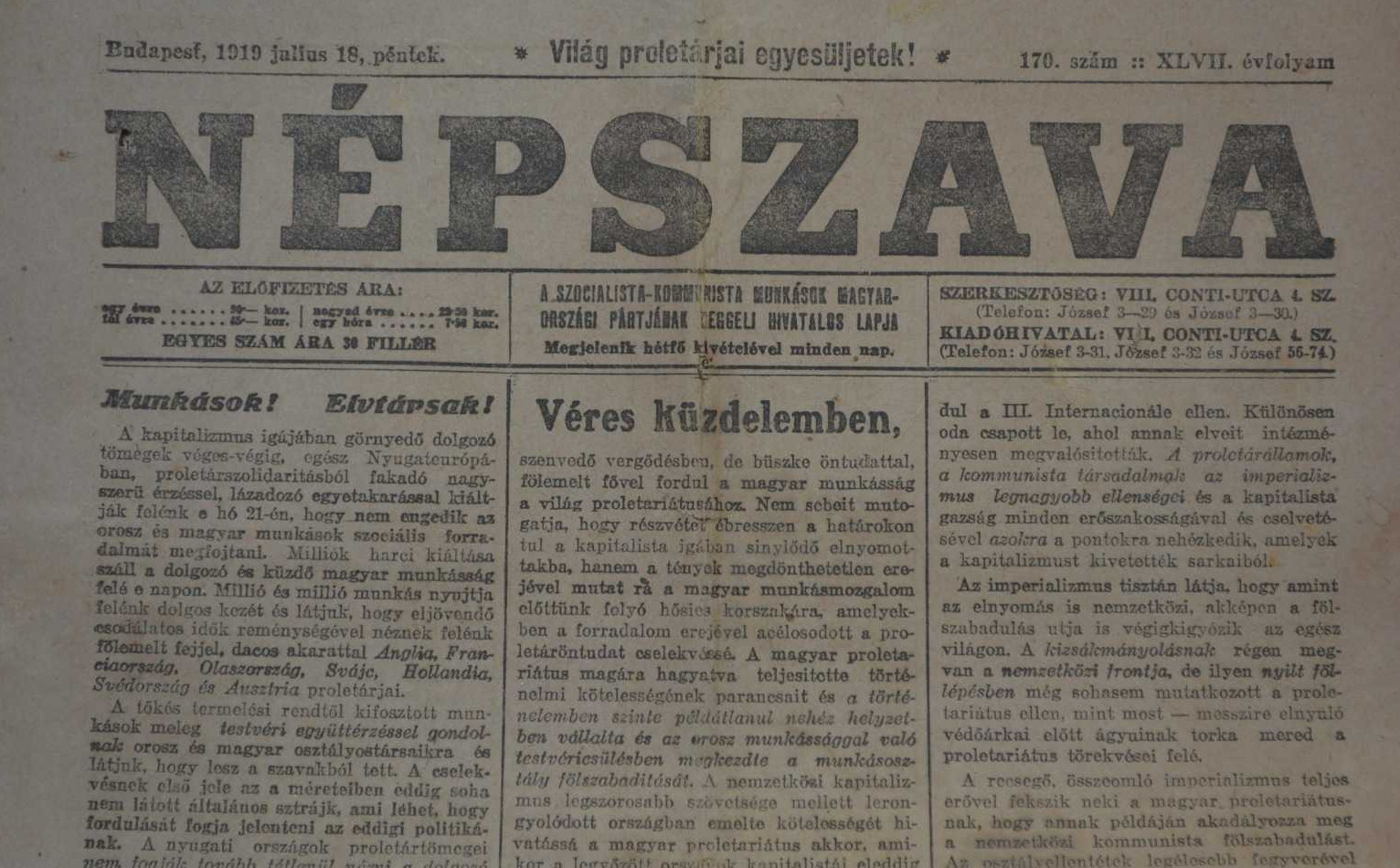 A Népszava article glorifies the “heroic” Kun regime (July 18, 1919)
A Népszava article glorifies the “heroic” Kun regime (July 18, 1919)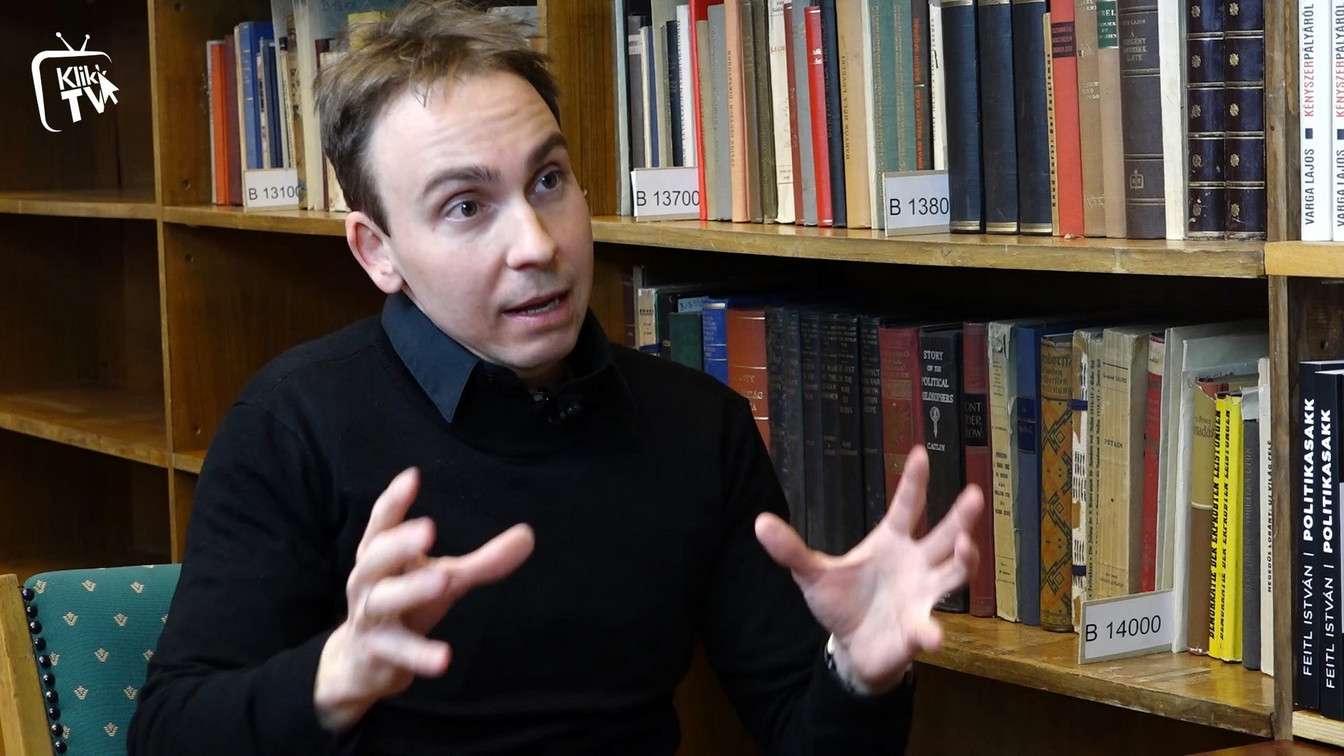 Péter Csunderlik (source: hirklikk.hu)
Péter Csunderlik (source: hirklikk.hu)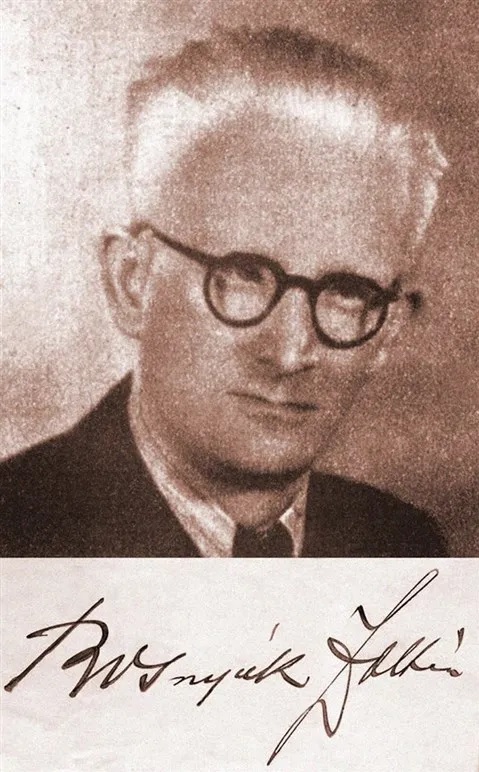 Zoltán Bosnyák
Zoltán Bosnyák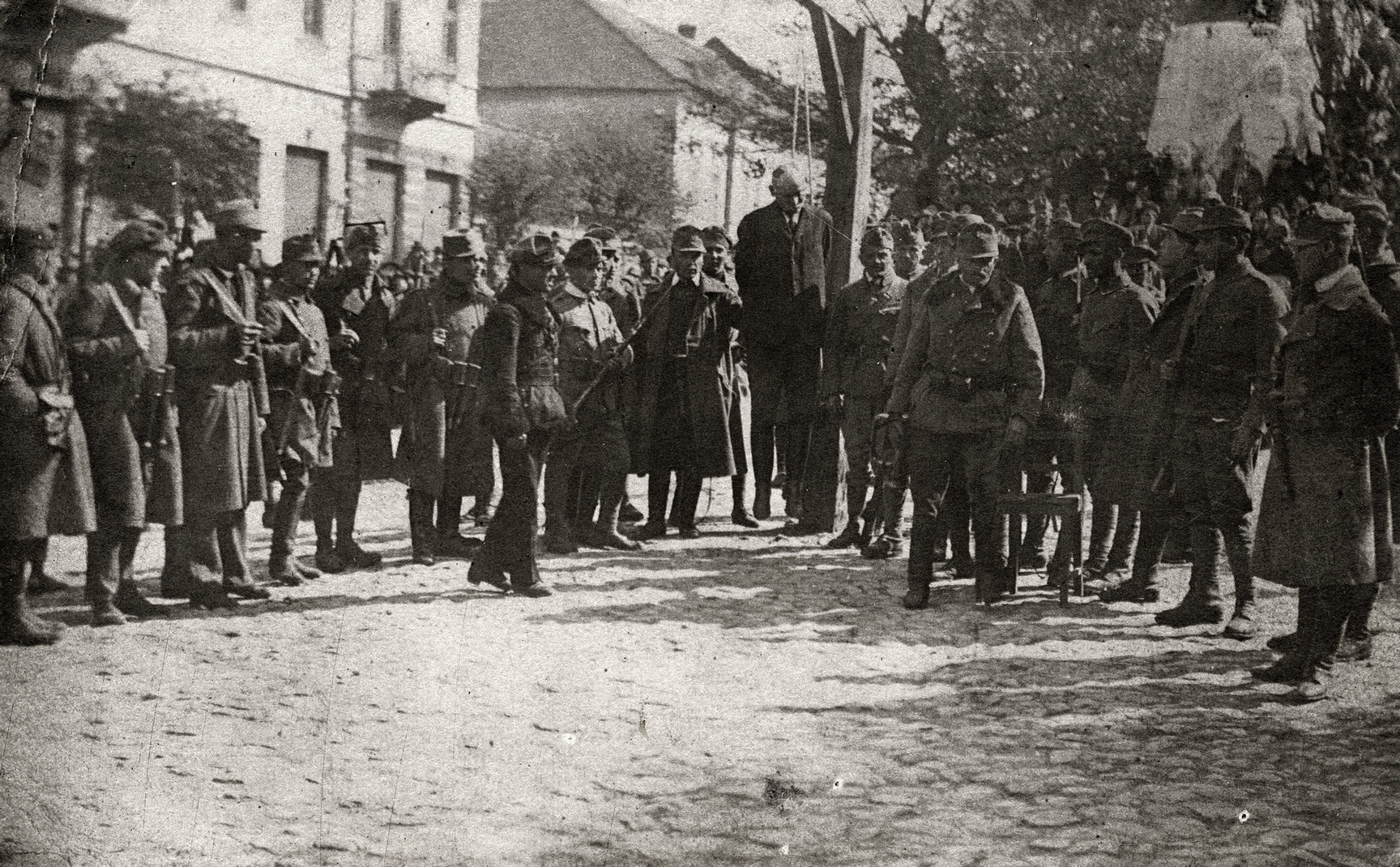 The sentencing and execution of József Papp by the Lenin Boys in Sátoraljaújhely (a city in the North-East of Hungary), April 22, 1919 (Hungarian National Museum)
The sentencing and execution of József Papp by the Lenin Boys in Sátoraljaújhely (a city in the North-East of Hungary), April 22, 1919 (Hungarian National Museum)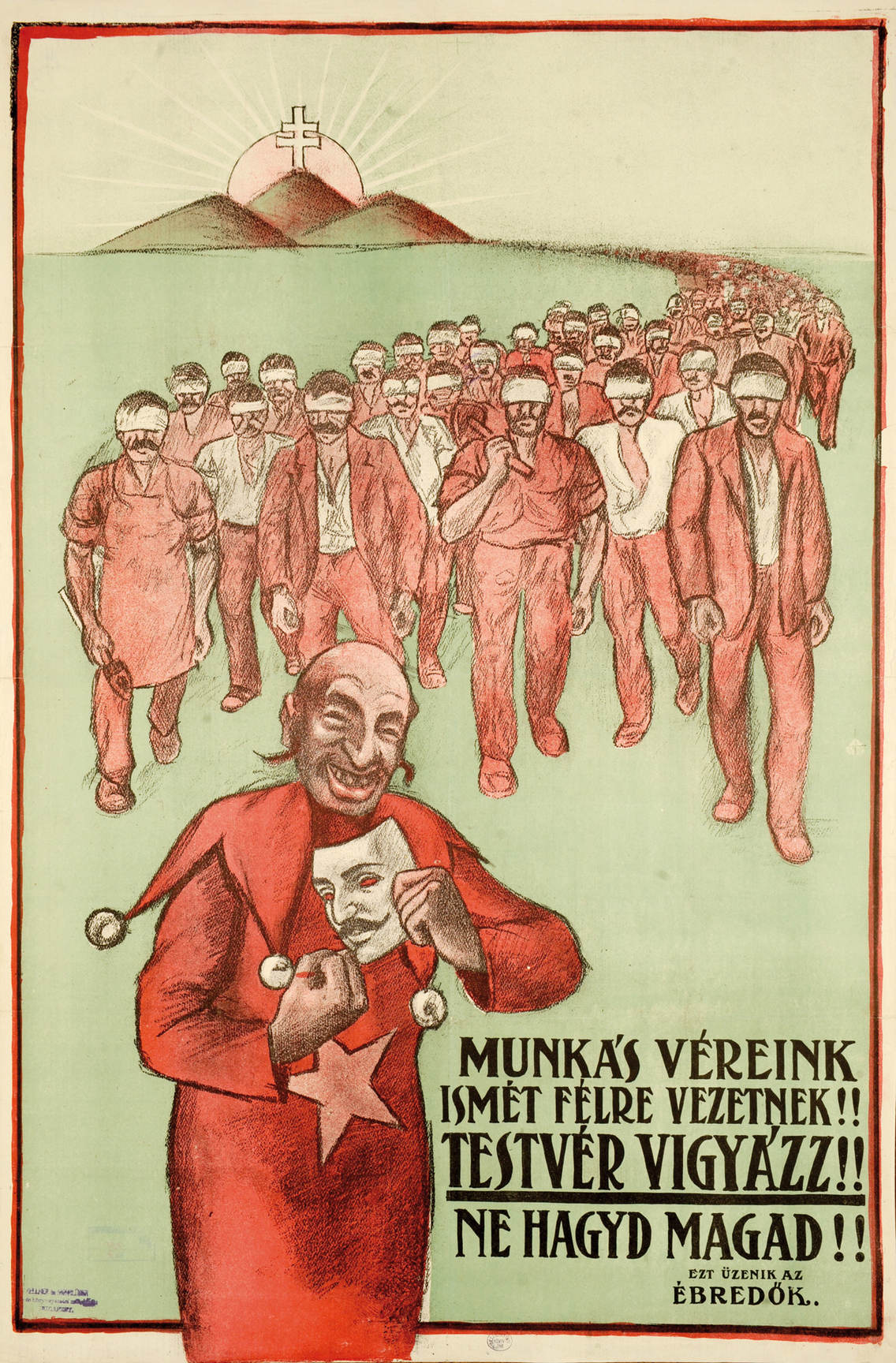 “Our worker brothers, you are being deceived again!! Watch out, brother!! Don’t let them!!”—poster of the Awakening Hungarians (Ébredő Magyarok) group warning after the fall of the Kun regime that Jewish influence did not disappear
“Our worker brothers, you are being deceived again!! Watch out, brother!! Don’t let them!!”—poster of the Awakening Hungarians (Ébredő Magyarok) group warning after the fall of the Kun regime that Jewish influence did not disappear



